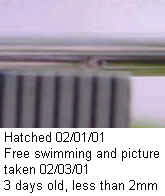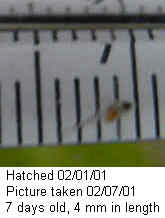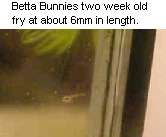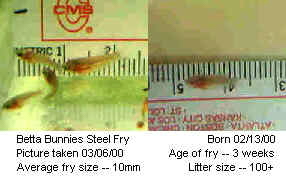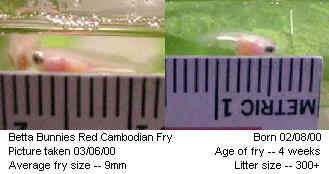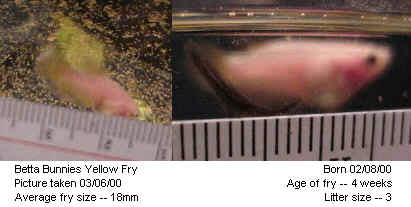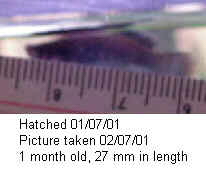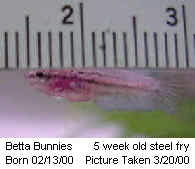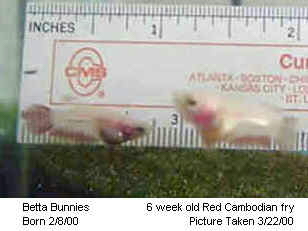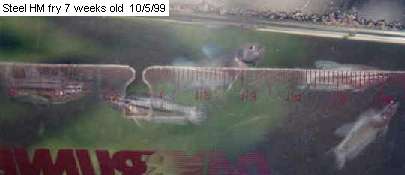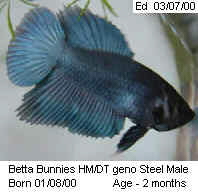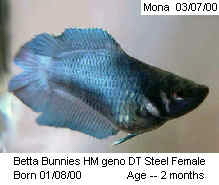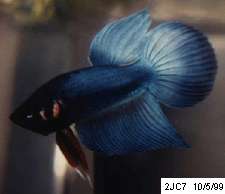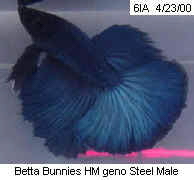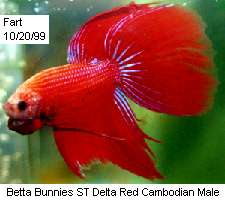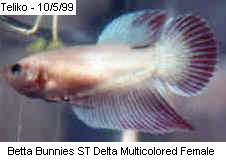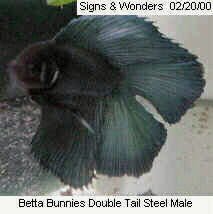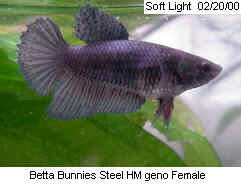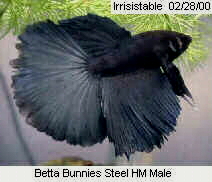Growing Betta Babies
Here is some information that visitors of my web page have asked me to add. The following are pictures of developing fry from the day they are born to the age of 6 months. In most cases I try to place a ruler in the photo to show the size of the developing fry and their physical changes as they grow and mature. On the picture itself is a key to the approximate size of the young. Included in the picture or in a caption below the picture is information on the age of the fry at the time the picture was taken. I hope to present this information in such a manner to help you understand the growth and development of the Betta splendens. If there are any questions, feel free to e-mail me at: dynarb@yahoo.com
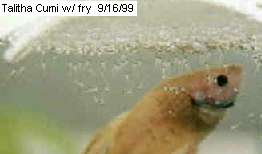
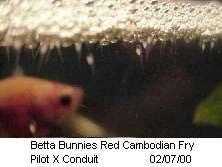
The one on the left is a picture of my yellow ST male, Talitha Cumi and his first litter. The fry have just hatched and are falling out of the nest. Talitha is busily picking up babies and blowing them back into the nest. The fry at this stage are about 2 to 3 mm from tip of head to tip of tail - usually called "commas with eyes" at this stage of development. On the right is a picture of my red cambodian male, Pilot and his first litter.
On the left is a picture of a newly free swimming fry at 3 days after hatching. The one on the right is a one week old fry. You can see it's full orange belly as a result of a recent feeding of baby brine shrimp. Average length is 2-3 mm. Unless otherwise noted, all lengths used on this page are in millimeters.
Gonna get a better one. This one of a 2 week old fry really sucks.
The fry on the left actually posed for me when I took the picture on 9/05/99. It is approximately 8.5mm in length, not counting the tail. I have blown up the picture to show you an exaggeration of what 3 week old fry might look like. By this time they have developed their labyrinth organ and are capable of breathing from atmospheric air. The horizontal stripes are typical of very young fry who usually do not start showing color until at least a month of age.
Here are some pictures I took for comparison purposes. As you can see, the litters are about the same age at the time the pictures were taken, but they are drastically different in size. You can see that none of the red cambodian litter are not showing color at this time. On the other hand, the yellow fry are not only showing their colors, but they are twice the size of their counterparts. The steel litter is even bigger, some even can be sexed. The red cambodian litter numbered over 300, were raised in a 10 gallon tank. The yellow cambodians, numbered only 3, were raised in a 5 gallon tank. The steels numbered about 20 and were raised in a 10 gallon tank. Differences in the size of the litter and availabliliy of a variety of foods make a big difference in the development of fry. You may also note, in the top photo of cambodians, you can see the swim bladder in both of the fry. It appears as a bubble down the center of the body that forms alongside the backbone.
Here are some pictures of 5 week old fry. There is a picture of some Double Tail's so you can see what 5 week old DT fry look like. The lone fry with the ruler is a HM/Black geno fry from the All Soul's/Pine Bluff litter born 2/13/00. The next 2 pictures are to help people to figure out what to look for when trying to see if their fish have a swim bladder problem or not. The fry are steel, so they are solid colored. You can still see the "bubble" that represents the swim bladder that forms along the backbone.
Here is a picture of my Red Cambodian fry at 6 weeks of age. As you can tell, they have developed quite a bit. They now have color showing, although different cambodian litters show colors at different ages. Some show a lot of color such as the one on the left, and other still show no color at all.
There is a very obvious developmental difference from the previous picture of 5 week old fry. You can easily tell that these guys are steel in color. The one closest to the surface turned out to be male. If you look closely, you can see that his color is more pronounced verses the stripes of some of the others, and his finnage looks a bit fuller. The size is about 20mm or 2cm in length.
This a young Black HM genotype male from the litter pictured above. I isolated him when he turned 8 weeks. He was in his own tank of about 3/4 of a gallon. When I moved him, he showed stripes typical of a young fish and then quickly adapted to his new surroundings by darkening in color, more so than it was in the tank in which he was raised. At 8 weeks of age, or 2 months, the majority of this litter was 4cm or about 1½ inches. As you can tell, the fish has nearly doubled it size and developed a lot more color.
These young males were both 3 months of age at the time the photo was taken. They both are showing their colors, the one one the left a Royal Blue and the one on the right a HM Steel. The blue male is showing the roundedness in the tail normally seen in young fish, usually veiltails, roundtails or so-so deltas. True halfmoons will show full hm spread and near halfmoon/super deltas will show a near 180, usually 160 or 170, degree spread at this stage of development.
These are a couple of 4 month old males. Fart, on the left, was separated at 6 weeks into a 2 gallon tank to himself due to his quick growth. The one on the right is a black male from the All Soul's/ Pine Bluff litter. Picture pending.
On the right is is a 5 month old female. If you look closely, you can see the eggs in her body and a well formed and obvious ovipositor showing just in front of her anal, or bottom, fin. The tiny white dot for you beginners. On the left is a 5 month old Double Tail Steel male.
Here is a couple of 6 month old steels. They are both from the same litter and are definately ready to be bred at this age.




